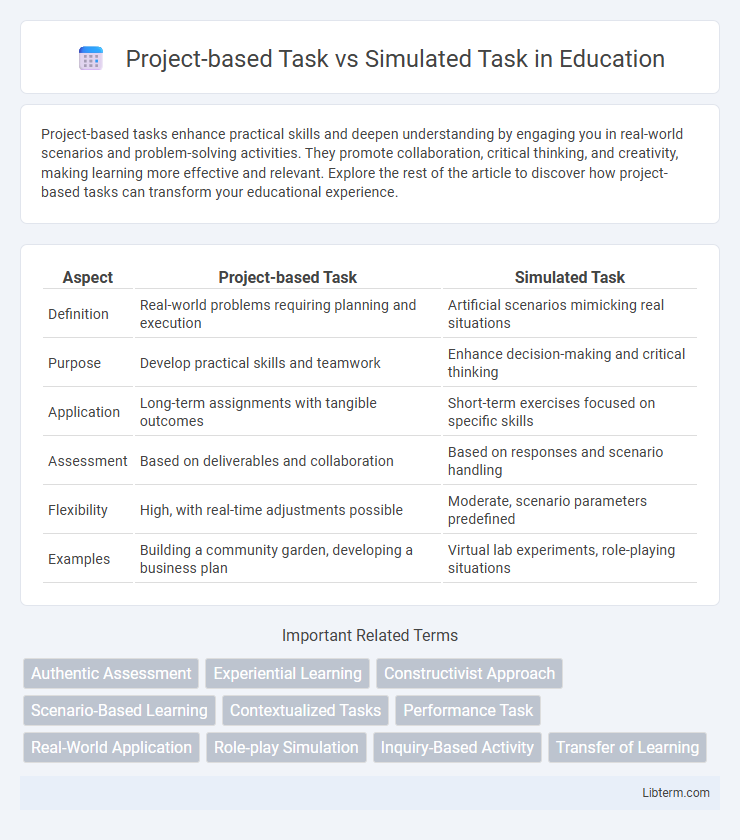Project-based tasks enhance practical skills and deepen understanding by engaging you in real-world scenarios and problem-solving activities. They promote collaboration, critical thinking, and creativity, making learning more effective and relevant. Explore the rest of the article to discover how project-based tasks can transform your educational experience.
Table of Comparison
| Aspect | Project-based Task | Simulated Task |
|---|---|---|
| Definition | Real-world problems requiring planning and execution | Artificial scenarios mimicking real situations |
| Purpose | Develop practical skills and teamwork | Enhance decision-making and critical thinking |
| Application | Long-term assignments with tangible outcomes | Short-term exercises focused on specific skills |
| Assessment | Based on deliverables and collaboration | Based on responses and scenario handling |
| Flexibility | High, with real-time adjustments possible | Moderate, scenario parameters predefined |
| Examples | Building a community garden, developing a business plan | Virtual lab experiments, role-playing situations |
Understanding Project-Based Tasks
Project-based tasks engage learners through authentic, real-world challenges that require planning, collaboration, and critical thinking, promoting deeper understanding and retention of knowledge. These tasks involve creating tangible outcomes or products, emphasizing applied skills over rote memorization, and fostering problem-solving abilities. Compared to simulated tasks, project-based tasks provide meaningful context and allow learners to connect theory with practice in dynamic, evolving scenarios.
Defining Simulated Tasks
Simulated tasks replicate real-world scenarios within a controlled environment, allowing learners to practice specific skills without real-world consequences. These tasks are designed to mimic authentic challenges by incorporating realistic variables, feedback, and constraints that mirror actual work settings. Unlike project-based tasks, simulated tasks emphasize skill acquisition through repetitive practice and immediate performance evaluation.
Key Differences Between Project-Based and Simulated Tasks
Project-based tasks require participants to complete real-world assignments with tangible outcomes, emphasizing practical application and problem-solving in authentic contexts. Simulated tasks, by contrast, involve artificial scenarios designed to replicate real-life challenges, focusing on controlled environments for skill assessment and training without real-world consequences. The key differences lie in the level of realism, outcome tangibility, and the nature of participant engagement, with project-based tasks fostering creativity and long-term impact, while simulated tasks offer risk-free practice and immediate feedback.
Learning Outcomes in Project-Based Tasks
Project-based tasks enhance learning outcomes by promoting critical thinking, problem-solving, and real-world application of knowledge, leading to deeper understanding and retention. These tasks often involve collaboration and active engagement, fostering communication skills and adaptability in diverse environments. Compared to simulated tasks, project-based approaches provide authentic experiences that better prepare learners for practical challenges and professional demands.
Learning Outcomes in Simulated Tasks
Simulated tasks enhance learning outcomes by providing realistic, controlled environments that promote critical thinking, problem-solving, and decision-making skills. These tasks facilitate immediate feedback and iterative practice, allowing learners to refine techniques without real-world consequences. Compared to project-based tasks, simulations better prepare learners for complex scenarios by closely mimicking actual professional challenges and contexts.
Real-World Applications: Project vs Simulation
Project-based tasks immerse learners in real-world problem-solving by requiring the creation of tangible outputs that mirror professional environments, enhancing practical skills and accountability. Simulated tasks replicate specific scenarios through controlled environments, enabling risk-free experimentation and targeted practice of complex processes or decision-making. Both approaches offer valuable experiential learning, but project-based tasks provide authentic real-world application, while simulations prioritize safe skill refinement and scenario familiarity.
Assessment Methods for Each Task Type
Project-based tasks emphasize authentic assessment methods such as portfolios, presentations, and real-world problem-solving evaluations to gauge comprehensive understanding and practical application. Simulated tasks rely on standardized assessments, including scenario-based tests, simulations, and role-playing exercises, to measure specific skills and decision-making abilities in controlled environments. Both methods integrate formative and summative assessments to provide a balanced evaluation of performance and learning outcomes.
Student Engagement and Motivation
Project-based tasks enhance student engagement by promoting hands-on learning and real-world problem solving, which significantly boosts intrinsic motivation. Simulated tasks offer controlled environments that allow students to experiment and receive immediate feedback, fostering sustained interest and confidence. Both approaches support active learning but project-based tasks often drive deeper commitment by connecting academic content to tangible outcomes.
Challenges and Limitations
Project-based tasks often face challenges such as extended timelines, resource constraints, and the complexity of coordinating multiple team members, which can limit timely completion and scalability. Simulated tasks, while controlled and repeatable, may suffer from a lack of real-world unpredictability and reduced participant engagement, hindering the transferability of skills. Both approaches encounter limitations in accurately measuring performance outcomes due to variability in task design and execution environments.
Choosing the Right Task for Learning Goals
Project-based tasks immerse learners in real-world scenarios that foster critical thinking, problem-solving, and collaboration, making them ideal for developing practical skills and interdisciplinary understanding. Simulated tasks replicate specific environments or situations to hone targeted skills through controlled, repeatable practice, which is effective for mastering precise competencies or troubleshooting. Selecting the right task depends on learning goals: choose project-based tasks for comprehensive skill application and simulations for focused skill refinement and assessment.
Project-based Task Infographic

 libterm.com
libterm.com